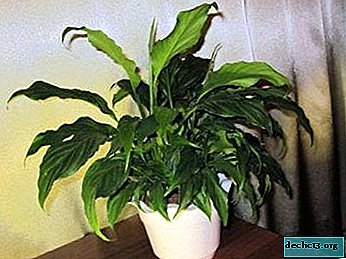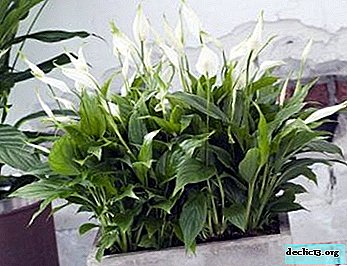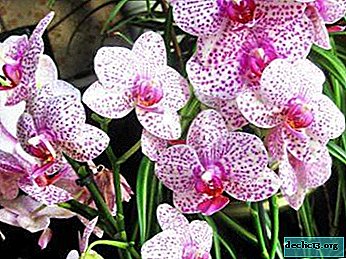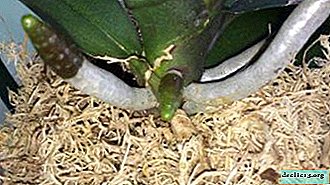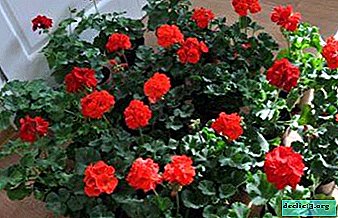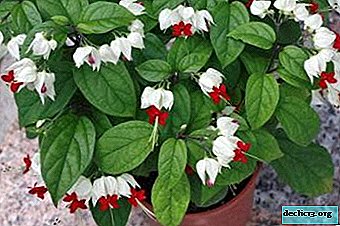All about Aloe spinous: beneficial properties and features of care
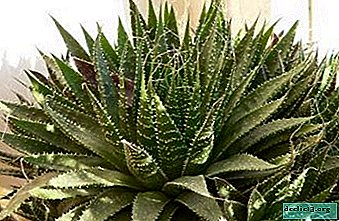
Aloe spinous is a fairly popular variety of aloe. It grows quickly, forming a decorative hemisphere. Spiky leaves are distinguished by a special decorative spinous tops - mustache. The plant is not whimsical to care for, and is suitable for breeding even for a beginner grower.
In this article, you will learn how to care for this type of aloe at home, what diseases can affect it, and how to propagate a plant using cuttings and leaves.
Botanical Description
Aloe spinous (aloe aristata) belongs to the genus Aloe of the Asphodelaceae family. Perennial succulent is a herbaceous plant. The birthplace of origin is southern Africa, the Kingdom of Lesotho. This aloe variety is often called haworthia.
In height, a plant in an apartment can grow up to 15 - 20 cm. The stalk is short. The bush is compact, dense. The leaves are thick, fleshy, jagged, rough, light green, with white dots, grow in a spiral. They grow up to 10 cm in length. The edges are pointed, at the ends there are twisted awns - white filiform spines. Spines are also located on the edges of the leaves. This feature is considered a hallmark of spinous aloe.
Leaves are collected in large sockets, up to 50-60 cm in diameter. The plant develops relatively quickly, in 1 year grows up to 6 - 8 new leaves.The flowers are orange, are yellow in color, are located on a long peduncle. The flowers are elongated, tubular in shape, connected in multi-flowered brushes. The root is branched, superficial.
Photo
Check out the aloe aristata photo below:




When and how does it bloom?
The plant usually blooms in late spring - early summer. The flower releases a straight arrow - peduncle. At the very top are spike-shaped inflorescences. Flowers of medium length, oblong, orange or yellowish. Flowering loose, rich.
Therapeutic and beneficial properties
The chemical composition of this plant is unique. It contains numerous amino acids - lycine, glycine, etc. Also included are polysaccharides, flavonoids, useful mineral compounds of zinc, iron and chlorine. This aloe variety is rich in vitamins B, carotene, ascorbic acid, tocopherol. The benefits of this houseplant extend to the following areas:
- In medicine, juice is used as a healing, antibacterial agent. Preparations made from natural raw materials are used in dentistry, gynecology, urology.
- In alternative medicine, spinous aloe leaves are used as a disinfectant, and are used for vitamin deficiency. Juice treats inflammation of the eyelids, visual impairment.
Healing juice can be used both externally and internally.
- In cosmetology, they are used for the manufacture of creams, dandruff shampoos, hair loss balms.
Home Care
Temperature
Aloe spinous loves warmth. The optimum growth temperature at home is 22 - 27ᵒС. The bush tolerates heat and drought.
During the rest period, the temperature of the content should not be allowed to drop below 12 - 10 ° C.
In summer, she feels good on open verandas and balconies, fresh air contributes to the growth and development of the flower.
Watering
 Watering must be very careful. A flower tolerates drought better than overflow. Only the substrate is moistened, in small doses, it should be watered under the root. Water should not get into the outlet, on the base of the leaves.
Watering must be very careful. A flower tolerates drought better than overflow. Only the substrate is moistened, in small doses, it should be watered under the root. Water should not get into the outlet, on the base of the leaves.
Summer watering is repeated when the top soil layer dries 1 - 1.5 cm deep. In winter, it should be watered 1-2 times a month. If the pots are not far from the radiators, watering can be increased.
The substrate should not be moist - the main condition for the content of spinous aloe.
Additional spraying with this flower is contraindicated.. Do not increase air humidity more than 40 - 50%. After watering, it is advisable to loosen the substrate slightly.
Water for irrigation should be at room temperature, clean, settled for at least 3 to 4 days.
Shine
Aloe spinous loves light, but direct sunlight is contraindicated. Pots are best installed on the southeast, southwest side of the apartment.
From a lack of light, the development of the peduncle slows down, flowering is problematic.In winter, you can add additional illumination for 2 to 3 hours a day, if the flower is in a poorly lit place.
Pruning
Shrub pruning is not required for this aloe variety.. Sanitary pruning is necessary when transplanting a flower. Dry, damaged by disease leaves and processes of roots are cut off. Also, after flowering, dry inflorescences are removed along with the stem.
Top dressing
The flower is fertilized only during active growth. Usually use special mineral fertilizing for succulents.
Aloe spinous is fed no more than 2 times a month through irrigation.
Pot
Planting containers can be chosen from any material, the flower is not whimsical. The pot is usually used not too deep, but spacious enough, in accordance with the structure of the root system. When planting, branched processes of the roots should be freely located in the tank.
Transfer
 Transplants are usually engaged in March - April. Young flowers are transplanted every year. Reaching 5 - 6 years of age, you can plant the plant in a year. The soil should be loose, light. A special substrate is used for cacti or succulents. You can make the mixture yourself.
Transplants are usually engaged in March - April. Young flowers are transplanted every year. Reaching 5 - 6 years of age, you can plant the plant in a year. The soil should be loose, light. A special substrate is used for cacti or succulents. You can make the mixture yourself.
Soil composition:
- Sod land - 2 hours
- Sheet land - 1 h.
- Coarse sand - 1 hour.
- Expanded clay drainage.
For acid balance, you can add a little peat to the substrate.
The transplant procedure is not complicated:
- A drainage layer with a height of 2 - 3 cm is placed.
- The substrate is poured.
- The soil is being moistened.
- The flower is transplanted with an earthen lump, the method of transshipment is used.
- The temperature of the content is 20 - 22 ° C.
- Pots are not immediately exposed to the bright sun; seedlings are tamed gradually to the sun.
Breeding
Stem cuttings
This method is the most painless and acceptable for spinous aloe. Separate cuttings - children can have a three-year-old flower. Parts of the stem are separated at the bottom of the outlet.
The procedure is carried out in the spring:
- Separated cuttings are treated with wood ash or activated carbon.
- Dry the cuttings for 24 hours in the shade.
- Planting stems are planted in a moistened substrate.
- Small pots are used to root the cuttings; it is not recommended to plant them in a large pot immediately.
- Mild regular moistening of the substrate is necessary.
- After rooting, seedlings are planted in separate pots.
Leafy cuttings
This method does not give a 100% guarantee of success. Leaves often rot, roots sprout slowly.
Sheet separation scheme:
 The leaf separates large, large, at the base.
The leaf separates large, large, at the base.- The sheet is dried for 24 hours in the refrigerator.
- The cut site is treated with root growth hormone.
- In the landing container is placed drainage, soil mixture.
- The surface of the soil is well moistened.
- Leaves are deepened by 2 - 3 cm.
- Seedlings are covered with a film.
- Daily ventilation is required, air temperature - 22 - 24 ᵒС.
- Rooting takes place within 3 to 4 weeks.
Diseases briefly
Diseases and pests occur due to improper watering. The main ones include:
- From excessive moisture, gray and root rot appears, worms start. Need bush treatment with insecticides, partial replacement of the substrate, sanitary pruning or transplantation.
- Spider mites and scale insects may appear from heat and stale air. Wash the leaves with a soap solution or methyl alcohol diluted with water in a 1: 1 ratio.
- From a sharp drop in temperature, leaf spotting appears.
- From a lack of light, shoots are drawn, decorativeness is lost.
In order for the spinous aloe to fully develop, flowering occurred on time, and was long, it is necessary to strictly observe the conditions of the plant.

 The leaf separates large, large, at the base.
The leaf separates large, large, at the base.

